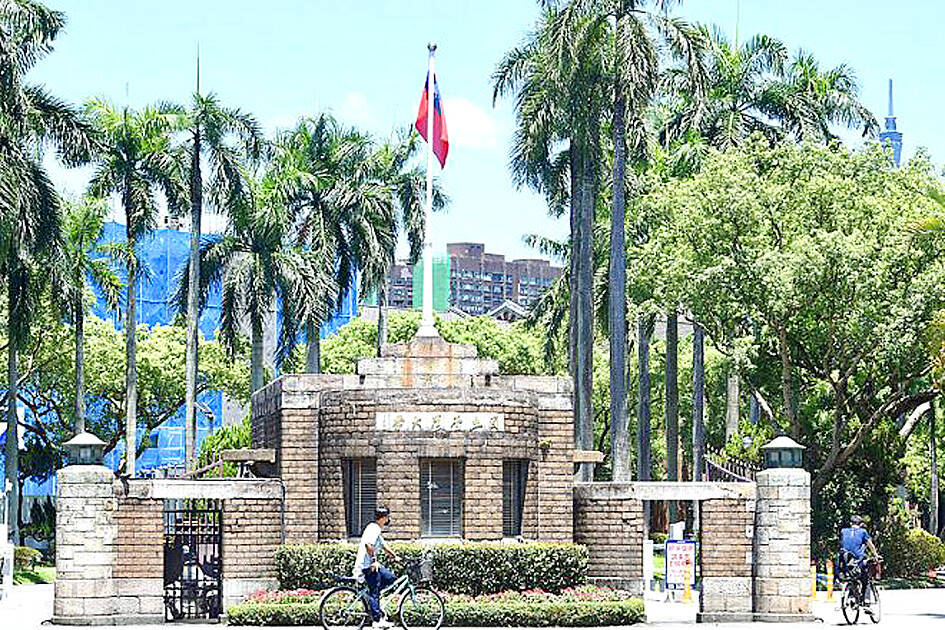National Taiwan University (NTU) and six other schools implemented mental health leave for students in the new semester, increasing the number to 18 schools, 12 percent of universities in the nation, the Ministry of Education (MOE) said.
Students applying for leave do not have to attend classes, and they can have time to deal with their personal issues arising from emotional problems or stress, said MOE Department of Student Affairs and Special Education Director Wu Lin-hui (吳林輝) on Saturday, adding that mental support service for the student must be approved by their universities’ counselors.
Kaohsiung-based National Sun Yat-sen University last year initiated a mental health leave program and became the first university to do so, university president Cheng Ying-yao (鄭英耀) said.

Photo: Lo Pei-de, Taipei Times
The university does not have a limit on how many times an individual can take such leave, but if a student applies more than three times in one semester, a school counselor would step in, Cheng said, adding that there were 662 applications made in the last school year, or 3.83 percent of its students.
Last year, 11 universities initiated such programs, and 29,582 students took mental health leave in the fall and spring semesters, Wu said.
NTU approved the implementation of a mental health leave program this month, along with four other state universities including National Taipei University, National Central University, National Chiayi University and National Pingtung University. Two private universities, Feng Chia University and Chinese Culture University also launched such programs.
NTU students can apply to take mental health leave not more than three times per semester, NTU officials said.
National Central University students can take up to five days of mental health leave per semester, but cannot use such leave to skip an exam.
Taipei Medical University also limits mental health leave with five days per semester, with a student’s adviser or professor being required to take active steps to help the student after three days of mental health leave.
Taiwan Youth Association for Democracy director Alvin Chang (張育萌) said the program provides good support for students, and the limits can prevent the practice from being abused.
A student at NTU College of Law and Politics said that he was feeling down when last semester started, so he applied for mental health leave and it helped him to feel better, and he eventually returned to his classes.
Another student, surnamed Wu (吳), at National Taiwan Normal University said that he got insomnia a while ago and the leave helped him sort out his sleeping problem.
Additional reporting by Jason Pan

Three Taiwanese airlines have prohibited passengers from packing Bluetooth earbuds and their charger cases in checked luggage. EVA Air and Uni Air said that Bluetooth earbuds and charger cases are categorized as portable electronic devices, which should be switched off if they are placed in checked luggage based on international aviation safety regulations. They must not be in standby or sleep mode. However, as charging would continue when earbuds are placed in the charger cases, which would contravene international aviation regulations, their cases must be carried as hand luggage, they said. Tigerair Taiwan said that earbud charger cases are equipped

UNILATERAL MOVES: Officials have raised concerns that Beijing could try to exert economic control over Kinmen in a key development plan next year The Civil Aviation Administration (CAA) yesterday said that China has so far failed to provide any information about a new airport expected to open next year that is less than 10km from a Taiwanese airport, raising flight safety concerns. Xiamen Xiangan International Airport is only about 3km at its closest point from the islands in Kinmen County — the scene of on-off fighting during the Cold War — and construction work can be seen and heard clearly from the Taiwan side. In a written statement sent to Reuters, the CAA said that airports close to each other need detailed advanced

Tropical Storm Fung-Wong would likely strengthen into a typhoon later today as it continues moving westward across the Pacific before heading in Taiwan’s direction next week, the Central Weather Administration (CWA) said. As of 8am, Fung-Wong was about 2,190km east-southeast of Cape Oluanpi (鵝鑾鼻), Taiwan’s southernmost point, moving westward at 25kph and possibly accelerating to 31kph, CWA data showed. The tropical storm is currently over waters east of the Philippines and still far from Taiwan, CWA forecaster Tseng Chao-cheng (曾昭誠) said, adding that it could likely strengthen into a typhoon later in the day. It is forecast to reach the South China Sea

WEATHER Typhoon forming: CWA A tropical depression is expected to form into a typhoon as early as today, the Central Weather Administration (CWA) said yesterday, adding that the storm’s path remains uncertain. Before the weekend, it would move toward the Philippines, the agency said. Some time around Monday next week, it might reach a turning point, either veering north toward waters east of Taiwan or continuing westward across the Philippines, the CWA said. Meanwhile, the eye of Typhoon Kalmaegi was 1,310km south-southeast of Oluanpi (鵝鑾鼻), Taiwan’s southernmost point, as of 2am yesterday, it said. The storm is forecast to move through central